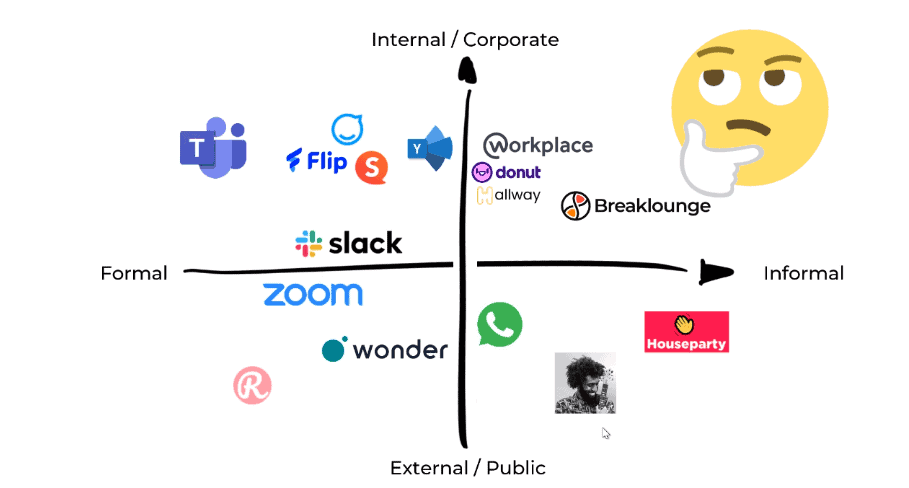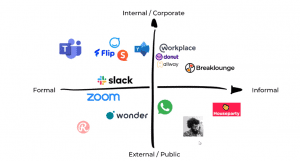The Social Software Landscape by Breaklounge
Whether for decentralized teams or for employees working from home, there is a wide range of social software tools available today for every communication purpose. They all support human communication, collaboration and social network building.
Many of these tools offer similar features, but are still different.
To help you keep an overview of different social software tools, we’ve designed the Social Software Landscape. We have positioned the included tools according to their intended use and features.
What do the axes of the Landscape mean?
The Internal/Corporate axis indicates whether a tool is intended for use in companies and is used for internal communication.
The External axis indicates whether communication is directed inward or outward.
The Formal axis indicates whether the tool’s functions primarily serve structured working processes – and less to strengthen team spirit and cohesion.
The Informal axis indicates whether the functions of the tool serve to maintain human relations and to exchange knowledge, experience and ideas.
A brief introduction to social software tools
The range of listed tools is broad. In addition to the top dogs MS Teams, Slack, WhatsApp and Facebook, specialized tools are also represented.
Microsoft Yammer, for example, is aimed at companies, is used to share knowledge and employee communication, and supports the creation and maintenance of networks.
As an enterprise communications platform, Workplace by Facebook takes a similar approach to Yammer and is – of course – inspired by Facebook in terms of features.
Flip, Staffbase and SpeakUp are three employee apps included in our Landscape. They are mainly used for internal communication and are designed to enable employees to exchange information and obtain relevant corporate information via their mobile devices.
Recently, the range of video conferencing solutions has grown considerably, with Zoom leading the way, of course. Unlike Zoom, Wonder and Remo are videoconferencing solutions used primarily for digital events and conventions.
Houseparty takes on a special role. Here, the name says it all: the app allows multiple people to make video calls. Unlike other providers, users can also talk to their friends’ friends. What is not possible in a house party: meet in different rooms to talk about different topics.
The prize for the most recent fuss goes to Clubhouse. The app is not yet open and available for everyone to use, but it has brought a lot of attention to the spoken word and the principle that “the whole world can listen.”
The “random generators” in terms of social software tools form the conclusion. Donut, Hallway, Meetrella play a round of chat roulette with the users. Interlocutors are randomly assigned. The application is literally without guarantee … Chance also plays a certain role in WhatsApp. Group conversations can be started quickly and easily, but take place in a single space (the group) for everyone. It is unclear who has the time and inclination to talk at the moment.



